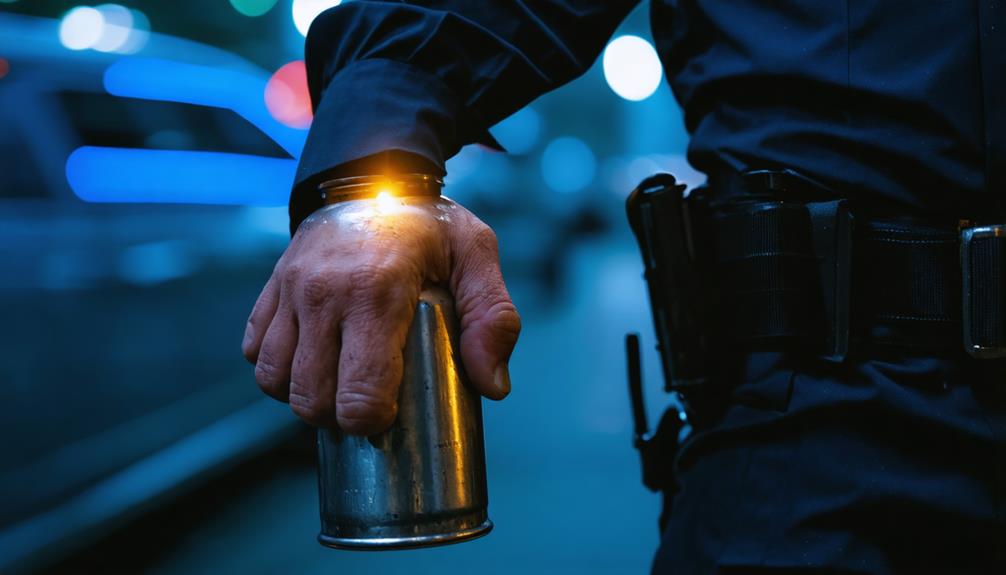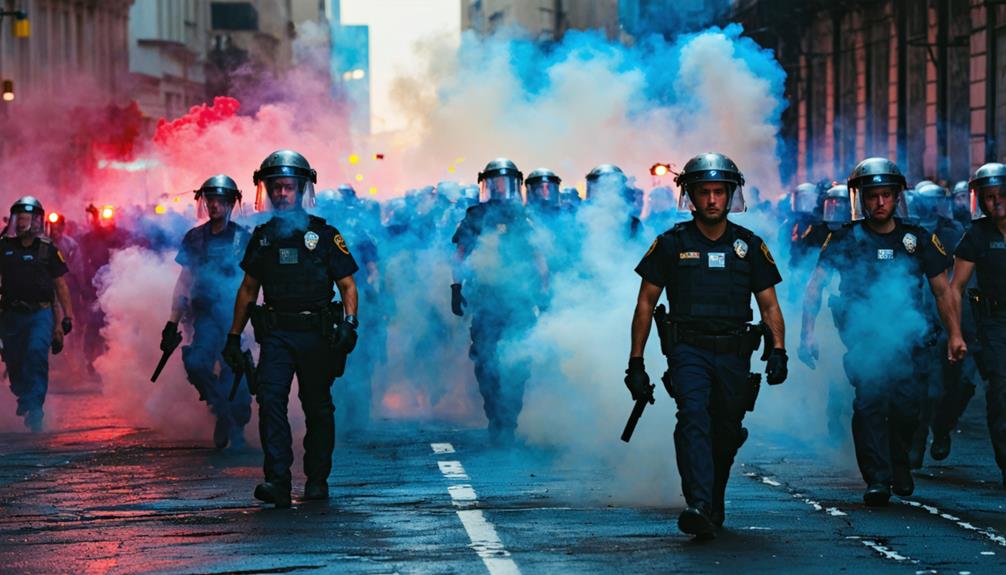
Brainstorm Security Shop

For Orders Over $199

On Any Of Our Products

Details On Refund Page

The use of police mace has sparked considerable debate within law enforcement and the communities they serve. This tool, designed for non-lethal incapacitation, raises questions about its ethical implications, effectiveness, and potential health risks. As police departments strive to balance officer safety with public trust, the nuances of mace deployment become increasingly significant. With incidents of misuse and public concern on the rise, understanding the comprehensive guidelines and alternative strategies becomes crucial. How can law enforcement achieve the delicate equilibrium between maintaining order and protecting civil liberties? The exploration of these issues reveals much about the future of policing tactics.
The history of police mace is deeply interwoven with the evolution of law enforcement tactics and crowd control measures. The advent of mace as a non-lethal weapon marked a significant turning point in policing, emphasizing the need for effective yet less harmful methods of subduing individuals and managing large gatherings. Developed in the mid-20th century, mace underwent several iterations, reflecting the evolving needs and challenges faced by law enforcement agencies.
Initially introduced as an irritant spray, mace quickly gained traction due to its capacity to incapacitate a person temporarily without causing long-term harm. The mace evolution can be attributed to continuous research and development aimed at enhancing its effectiveness while minimizing risks.
This evolution was paralleled by advancements in police training, ensuring officers were adequately equipped to deploy mace judiciously and safely. Comprehensive training programs were instituted to instruct law enforcement personnel on the appropriate use of mace, emphasizing restraint and discretion to prevent misuse.
Moreover, the integration of mace into standard police equipment highlighted a paradigm shift towards prioritizing de-escalation techniques. As such, mace became an integral component of modern policing, reflecting broader societal demands for humane law enforcement practices.
Mace, as a foundational element in the history of non-lethal crowd control, paved the way for a broader spectrum of chemical sprays employed by law enforcement today. Among these, pepper spray, tear gas, and CS gas are the most prevalent, each with unique properties and intended uses.
Pepper spray, derived from capsaicin, targets the eyes and respiratory system, causing intense irritation and temporary incapacitation. Its spray efficacy is often evaluated based on its ability to disperse in a fine mist, maximizing coverage while minimizing collateral exposure.
Tear gas, primarily containing chlorobenzylidene malononitrile (CS) or chloroacetophenone (CN), is designed to be deployed in crowd control scenarios. Its application techniques range from handheld canisters to grenade-style dispersal, allowing flexibility depending on the situation’s scale and complexity.
Meanwhile, CS gas, another potent irritant, is favored for its rapid onset of action and effectiveness in dispersing large groups.
These chemical agents are indispensable tools for modern law enforcement, with their application techniques evolving to enhance both safety and effectiveness. Understanding the nuances of each spray type’s efficacy ensures that officers can make informed decisions in dynamic operational environments.

Navigating the legal landscape surrounding the use of chemical sprays by law enforcement requires a thorough understanding of both international and national regulations. Mace legislation varies significantly across jurisdictions, reflecting differing priorities regarding public safety and human rights. Internationally, the United Nations has established guidelines emphasizing the need for chemical safety, stipulating that such tools should only be used when absolutely necessary and in a manner that minimizes harm.
In the United States, specific regulations guiding mace usage are often determined at the state level, with federal oversight ensuring compliance with broader human rights standards. Training protocols are crucial, as they ensure officers understand both the tactical applications and the potential legal ramifications of deploying chemical sprays.
| Jurisdiction | Key Regulation |
|---|---|
| United Nations | Emphasizes necessity and minimal harm |
| United States | State-specific, with federal oversight |
| European Union | Focuses on proportionality and safety |
European Union directives also highlight the importance of proportionality and chemical safety, urging member states to adopt comprehensive training and strict accountability measures. Legal frameworks in these regions are designed to balance the need for effective law enforcement with the imperative to safeguard individual rights, ensuring that the deployment of mace is both judicious and legally compliant.
Understanding the legal framework is only part of the equation; equally significant are the health impacts that chemical sprays like mace can have on individuals. When deployed, mace releases a fine mist that can cause immediate physical reactions such as coughing, skin irritation, and temporary blindness.
However, beyond these acute responses, there exist concerns regarding the psychological effects and potential long term health implications.
Exposure to mace can result in significant psychological effects. The sudden onset of pain and disorientation can lead to heightened anxiety and panic. In certain cases, individuals may experience post-traumatic stress symptoms, particularly if exposure occurs during a distressing situation.
The psychological toll can be profound, especially for those with pre-existing mental health conditions, exacerbating symptoms and complicating recovery.
Long term health concerns are also noteworthy. Repeated exposure could potentially lead to chronic respiratory issues or sensitization to other chemical irritants.
Individuals with asthma or other pre-existing respiratory conditions are particularly vulnerable, facing a heightened risk of severe complications. While research on the long term health effects of mace remains limited, these potential risks underscore the need for caution and further investigation into its impact on human health.

The misuse of mace by law enforcement has raised significant concerns regarding accountability and public safety. Numerous instances have been documented where police officers have employed mace in situations that did not warrant such force, leading to questions about the appropriateness of its use.
Misuse examples include deploying mace during peaceful protests, on restrained individuals, or in settings where less aggressive alternatives were available. These incidents highlight a troubling pattern where mace is utilized not as a last resort, but prematurely, thereby exacerbating tensions and escalating confrontations unnecessarily.
To address these issues, accountability measures are crucial. First, comprehensive training programs emphasizing de-escalation tactics and appropriate mace usage should be mandatory for all officers.
Furthermore, strict protocols need to be established, clearly defining when and how mace should be used, ensuring that its deployment is justified and proportionate to the situation at hand.
Additionally, implementing robust oversight mechanisms, such as independent reviews and body camera footage analysis, can aid in holding officers accountable for misuse.
Public perception of law enforcement’s use of mace has become a flashpoint for broader discussions about police practices and accountability. Concerns have emerged regarding the balance between maintaining public safety and fostering community trust.
As incidents involving mace gain public awareness, questions arise about the adequacy of training standards and the effectiveness of accountability measures.
The community’s fear of escalation during encounters with police is compounded by issues related to mental health and the potential for misjudging situations where mace is deployed. This anxiety underscores the need for:
These elements are critical in addressing the public’s concerns and reinforcing community relations.
As discussions continue, emphasis on accountability measures, clear guidelines, and enhanced training standards are paramount in fostering a sense of security and trust. The dialogue should remain open, ensuring that both law enforcement and the communities they serve work collaboratively towards a safer, more transparent future.

As police departments seek to reduce reliance on mace, the implementation of de-escalation training techniques is gaining traction as a crucial component in managing confrontational situations more effectively.
Additionally, fostering community engagement strategies can build trust and enhance mutual understanding between law enforcement and the public.
Evaluating non-lethal tools provides further avenues for officers to maintain safety while minimizing harm.
While mace is often considered a necessary tool for law enforcement, effective de-escalation training techniques provide viable alternatives that can enhance public safety and officer efficacy.
These techniques emphasize the importance of conflict resolution and the development of strong communication skills. By equipping officers with the ability to assess and address volatile situations without resorting to force, de-escalation training can significantly reduce the need for mace.
Key components of effective de-escalation training include:
These strategies underscore the potential of de-escalation training to transform interactions between law enforcement and the public, promoting safer and more harmonious outcomes.
Building on the foundation of de-escalation training, community engagement strategies offer a proactive approach to reducing reliance on tools like mace. Central to these strategies are community workshops designed to educate both law enforcement and citizens about mutual concerns and expectations. Such workshops foster dialogue, enabling meaningful citizen feedback that can guide neighborhood policing efforts.
By understanding community needs, police can tailor their approaches, increasing their effectiveness without resorting to force.
Neighborhood policing, another critical element, focuses on assigning officers to specific areas, allowing them to become familiar faces within the community. This familiarity aids in trust building and enhances cooperation during safety initiatives. Trust is further strengthened through youth outreach programs, which engage young residents in discussions about their role in community safety, reducing the likelihood of confrontations requiring force.
Partnership programs play a vital role by linking law enforcement with local organizations, facilitating resources and support for community-driven safety initiatives. Engagement events, such as town halls or cultural festivals, promote positive interactions, reinforcing community bonds.
In the realm of law enforcement, assessing non-lethal tools is crucial for ensuring both officer and public safety while minimizing harm. The effectiveness assessment of these alternatives to mace is paramount to understanding their potential and limitations. A rigorous evaluation process should include examining the tools’ impact on compliance, ease of use, and potential for unintended consequences.
Furthermore, implementing comprehensive training protocols is essential to maximize the safe and effective use of these tools. Officers must be well-versed in deploying these alternatives under varying circumstances, ensuring consistency in application and outcome.
Several non-lethal options are available for law enforcement, each requiring careful consideration:
Each tool’s deployment must be backed by evidence-based effectiveness assessments and robust training protocols. These steps ensure that the selected alternatives not only meet safety standards but also align with ethical policing practices, thus safeguarding public trust.
As technological advancements continue to enhance the formulation and delivery methods of mace, the future of its use in policing will be shaped by both innovation and increasing scrutiny.
Ethical concerns regarding its deployment raise questions about the balance between safety and excessive force, prompting calls for stricter regulations.
Policymakers and law enforcement agencies must collaboratively address these issues to ensure mace is used responsibly and effectively in modern policing.
Enhancing the efficacy and safety of mace in policing is at the forefront of technological advancements, as law enforcement agencies seek to modernize their non-lethal options. Contemporary spray technology has evolved significantly, offering varied delivery methods that are more precise and effective. Innovations focus on minimizing unintended exposure while maximizing impact on intended targets, thereby enhancing both officer and civilian safety.
Recent developments in spray technology include:
These advancements not only enhance operational effectiveness but also align with broader objectives for safer law enforcement practices.
The increasing integration of advanced mace technology in law enforcement raises a multitude of ethical concerns and necessitates stringent regulatory oversight. As these tools become more sophisticated, their potential to inflict harm or be misused becomes a significant issue.
Ethical implications emerge when considering the balance between maintaining public safety and respecting individual rights. The deployment of mace, particularly in crowd control situations, can lead to unintended injuries, raising questions about proportionality and necessity in its use.
To address these concerns, robust accountability measures must be implemented. Law enforcement agencies are tasked with developing comprehensive guidelines that dictate appropriate scenarios for mace use, thus ensuring that officers are adequately trained and aware of the potential consequences.
Furthermore, transparency in reporting and reviewing mace deployments is crucial. Regular audits and public disclosures of mace usage can foster trust within communities and ensure that law enforcement remains responsible for their actions.
The duration of mace effects can vary due to several factors, including individual sensitivity and environmental conditions. Typically, symptoms last from 30 minutes to two hours. Understanding these duration factors is crucial for maintaining personal safety during exposure.
Effectiveness in windy conditions depends on wind direction and adherence to safety precautions. Proper assessment ensures deployment minimizes unintended exposure. Operators should evaluate environmental factors to maintain control and effectiveness, ensuring target engagement while safeguarding bystanders and themselves.
The chemical composition of mace typically includes oleoresin capsicum, which is not classified as flammable or explosive. Safety regulations require thorough evaluation to ensure it is safely used in law enforcement without posing fire hazards.
Animal reactions to chemical irritants include respiratory distress and ocular irritation. Spray alternatives should be considered to minimize unintended harm to wildlife. Proper training and caution are essential to prevent accidental exposure and ensure humane enforcement practices.
Effective decontamination methods for chemical irritants involve thoroughly rinsing the affected area with water to alleviate skin irritation. Avoid rubbing the skin and seek medical attention if symptoms persist. Remove contaminated clothing to prevent further exposure.
The evolution of police mace underscores its dual role in law enforcement as both a tool for ensuring officer safety and a potential source of public concern. While its development and regulation aim to balance effectiveness and humanitarian considerations, incidents of misuse highlight ongoing challenges. Public perception remains divided, emphasizing the need for continued scrutiny and adaptation. Exploring alternative methods and enhancing training protocols will be crucial in aligning mace use with contemporary policing goals centered on de-escalation and community trust.
Brainstorm Security Shop
1867 Caravan Trail
Ste 105
Jacksonville, FL 32216
Call us toll free: (800) 859-5566